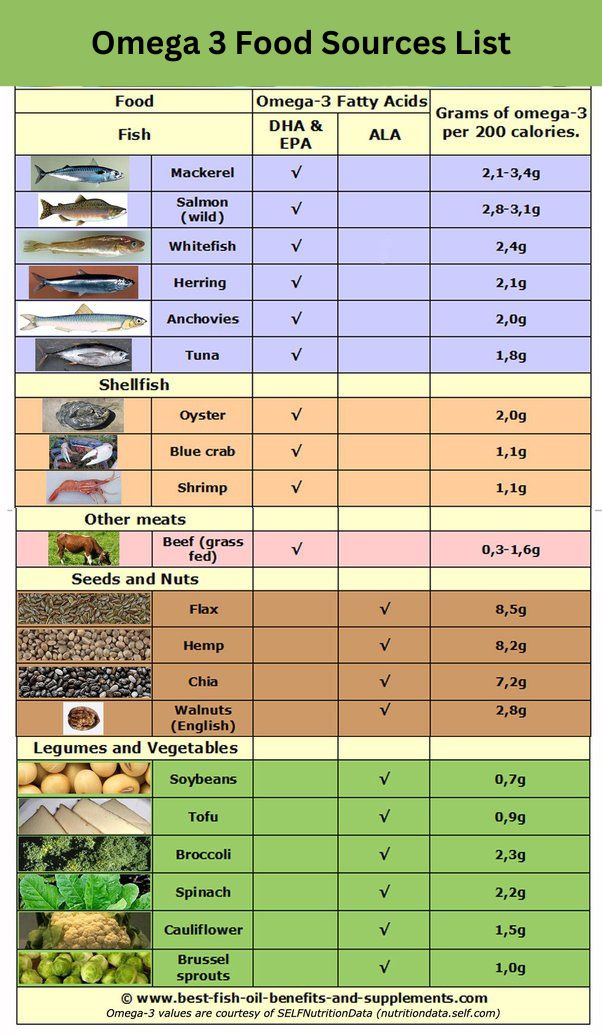Omega 3 Food Sources List
Below is a Omega 3 Food Sources List showing the foods that are highest in Omega 3 Fatty Acids, which includes DHA & EPA as well as ALA. Grams of Omega 3 per 200 calories.

Omega-3 fats: Oily fish such as salmon, herring, mackerel, and sardines; fish oil and flaxseed oil; flaxseeds, walnuts, and chia seeds. vs Omega-6 fats: Safflower oil, sunflower oil, corn oil, soybean oil, sunflower seeds, pumpkin seed
Omega-3 and omega-6 fatty acids are beneficial for health, however they must be in the ratio to optimise health and cholesterol.
Historically, humans traditionally ate these fats in a ratio of 1:1 – an equal amount of omega 6 and 3. But today, a modern Western diet may consist of 15 times more omega-6s than omega-3s. The best diet is to get as close to 1:1 as you can, or 1:2 no more than 1:4. That is for every gram of omega 3 fat you have no more than 4 times as much omega 6.
The most recent nutritional recommendations recommend substituting unsaturated fats like omega-6 for saturated fat. The Institute of Medicine and the AHA both advise consuming 5% to 10% of your daily calories from omega-6 fats. That equals 11 to 22 grams for a person who typically consumes 2,000 calories each day. Omega-6 fatty acids are found in one tablespoon of safflower oil, one ounce of sunflower seeds, and one ounce of walnuts in a salad dressing. Reference
The majority of Americans consume nearly ten times as much omega-6 fat than omega-3 fat. Omega-3 fat consumption must be balanced because a low intake is detrimental to cardiovascular health. Harvard recommend focusing on reducing omega-6 fats. Reference
What can I do to improve my Cholesterol?
Trans Fats and cholesterol
Trans fats are typically found in the following foods:
- Commercial baked goods, such as cakes, cookies and pies.
- Shortening.
- Bagels
- White rice
- Microwave popcorn.
- Frozen pizza.
- Refrigerated dough, such as biscuits and rolls.
- Fried foods, including french fries, doughnuts and fried chicken.
- Nondairy coffee creamer.
- Stick margarine.
“Unlike other dietary fats, trans fats — also called trans-fatty acids — raise “bad” cholesterol and also lowers “good” cholesterol. A diet laden with trans fats increases the risk of heart disease, the leading killer of adults. The more trans fats eaten, the greater the risk of heart and blood vessel disease.” Reference
- It is a good idea to reduce your consumption of these foods.
Why is eating Omega 3 Foods so important?
As the name states Essential Fatty Acids are essential. Omega 3 fats are essential fatty acids.
“Omega-3 fats are have been shown to help prevent heart disease and stroke, may help control lupus, eczema, and rheumatoid arthritis, and may play protective roles in cancer and other conditions. Omega-3 fats are a key family of polyunsaturated fats”. Reference
“There’s strong evidence that omega-3 fatty acids can significantly reduce blood triglyceride levels. There also appears to be a slight improvement in high-density lipoprotein (HDL, or “good”) cholesterol, although an increase in levels of low-density lipoprotein (LDL, or “bad”) cholesterol also was observed.” Reference
- So as we can see from the above statements Omega 3 Essential Fatty Acids are important to help maintain healthy cholesterol levels however it is is not the only thing that matters.
Eating too many simple sugars contributes to unhealthy cholesterol levels
“When you eat too much sugar, your liver makes more LDL while lowering the amount of HDL in your body. The extra calories from a sugary diet also leads to more of something called triglycerides, a type of blood fat that plays a role in your cholesterol health.” Reference
What causes a huge spike in triglycerides and why is it bad?
“Why do high triglycerides matter? High triglycerides may contribute to hardening of the arteries or thickening of the artery walls (arteriosclerosis) — which increases the risk of stroke, heart attack and heart disease. Extremely high triglycerides can also cause acute inflammation of the pancreas (pancreatitis).” Reference
“Diets high in calories, high-carbohydrate, low-fat diets, and obesity increase triglycerides. Vitamin D deficiency, smoking, an underactive thyroid, inflammation, genetics, and certain medications and diseases can also raise your levels.” Reference Jan 21, 2021
7-day meal plan to help lower triglycerides
Complex sugars, like those found in fruit and vegetables are sugars that are accompanied by fiber. Fruits, vegetables and whole grains contain sugars however they are considered complex carbohydrates. Whole plant foods, naturally found in nature, that are not processed contain fiber which slows the absorption of sugar.
- So when you think about reducing sugar, think about removing processed foods from your diet like cookies, cakes, candy, white bread etc. These foods lack naturally occurring fibre. They are nutrient empty and high in simple sugars. Instead replace these foods with fruits, vegetables and whole grains.
- Follow the Australian dietary guidelines which suggests eating 2 servings of fruits and 5 servings of vegetables each day.
Does fiber flush out cholesterol?
Soluble fiber helps to lower blood cholesterol levels. It dissolves in water to form a gel, which moves slowly through the intestines “grabbing” up fat, dietary cholesterol, bile salts, and sugar to be excreted.
“Modest increases in soluble fiber intake in healthy subjects improved LDL cholesterol and glucose levels.” Reference
- Women should consume around 25 grams of fiber a day and Men should consume around 30 grams. You can use my free Fiber Counter to check your daily fiber levels. The Fiber Counter App is available on the Apple Store and Google Play Store.
Consume adequate amounts of protein
Consuming adequate amounts of protein is important to help maintain muscle mass as well as healthy cholesterol levels. Protein is important because “higher-protein diets are associated with higher HDL cholesterol and lower BMI and waist circumference. This was indicated in a study in US adults when compared to protein intakes at RDA levels.
- “Data suggest that Americans who consume dietary protein between 1.0 and 1.5 g/kg of body weight potentially have a lower risk of developing cardiometabolic disease.” Reference. This in turn can help improve cholesterol levels.
Can vitamins help lower cholesterol?
Vitamin B3, or niacin, has been shown to increase levels of high-density lipoprotein (HDL), or good, cholesterol, and decrease triglyerides.
- “Niacin is a B vitamin that can help lower cholesterol. A person can also take other dietary supplements, such as fish oil, to help lower cholesterol. However, people should only use these products after speaking with a doctor”. Reference
- WebMd as well as Dr Mark Hyman advocates a good multivitamin and mineral supplement to help with cholesterol levels. Reference
- “Resveratrol might help prevent damage to blood vessels, reduce low-density lipoprotein (LDL) cholesterol (the “bad” cholesterol) and prevent blood clots.” Reference
- According to studies Fucoidan can help cholesterol. “Findings indicate that fucoidan improves serum lipid levels by regulating the expression of key enzymes of cholesterol and triglyceride syntheses in the liver through modulation of SREBP-2.” Reference
Is L Arginine good for high cholesterol?
A variant in the FADS1 gene is associated with decreased blood levels of Arachidonic Acid (AA) and Eicosapentaenoic acid (EPA). AA is a long chain omega-6 acid and EPA is a long chain omega-3 acid. Individuals with this genotype may have reduced blood levels of omega 3 and omega 6 fatty acids. A Smart DNA Wellness Test can determine if you have a variant in the FADS1 gene. Click here to order a test today.
In summary to improve cholesterol
- Avoid trans fats
- Increase Omega 3 in your diet
- Reduce Omega 6
- Reduce simple sugars and increase fiber
- Exercise and maintain a healthy weight
- Use natural ingredients to support your body
- Lastly, review your genetic profile.
